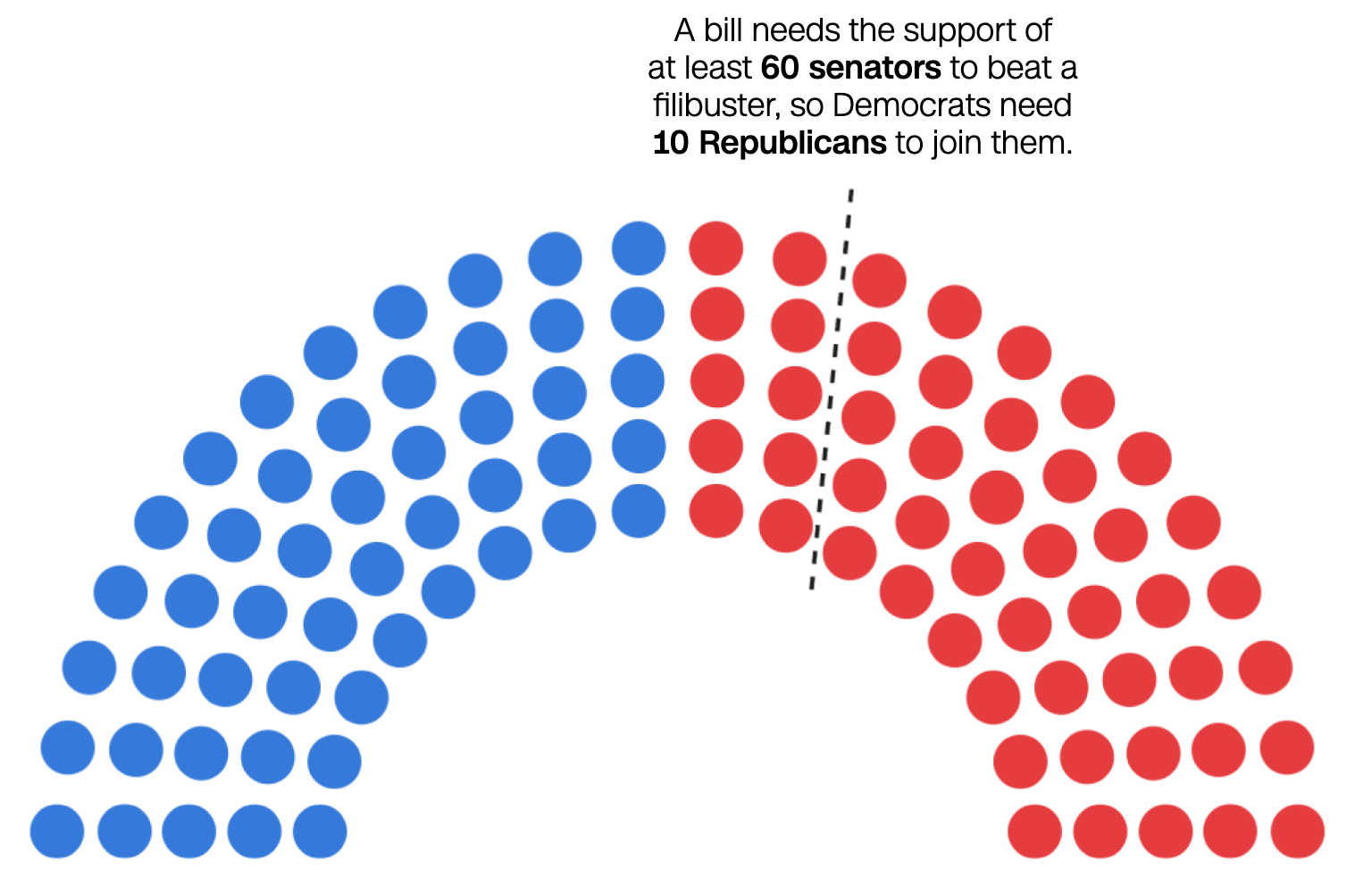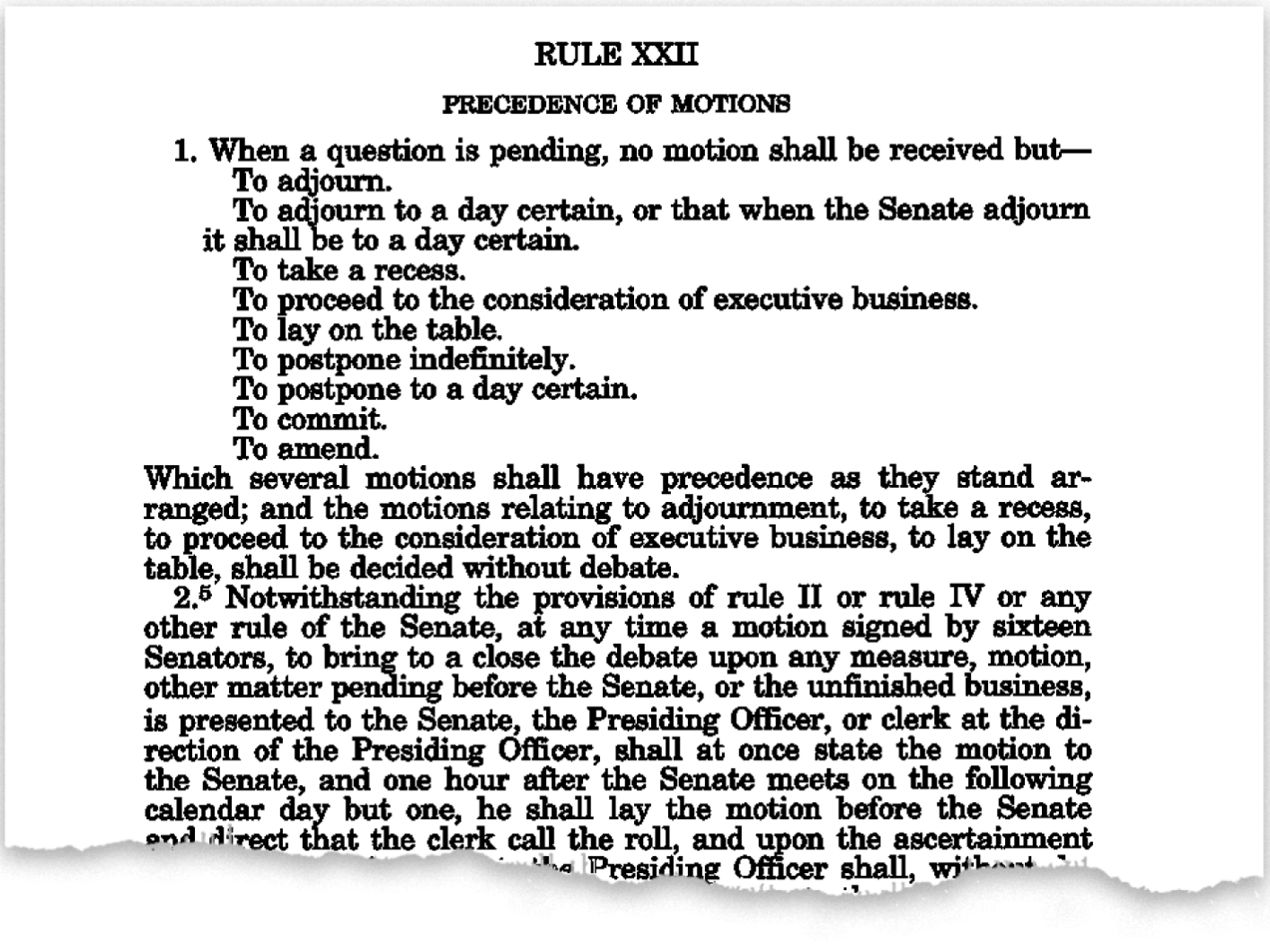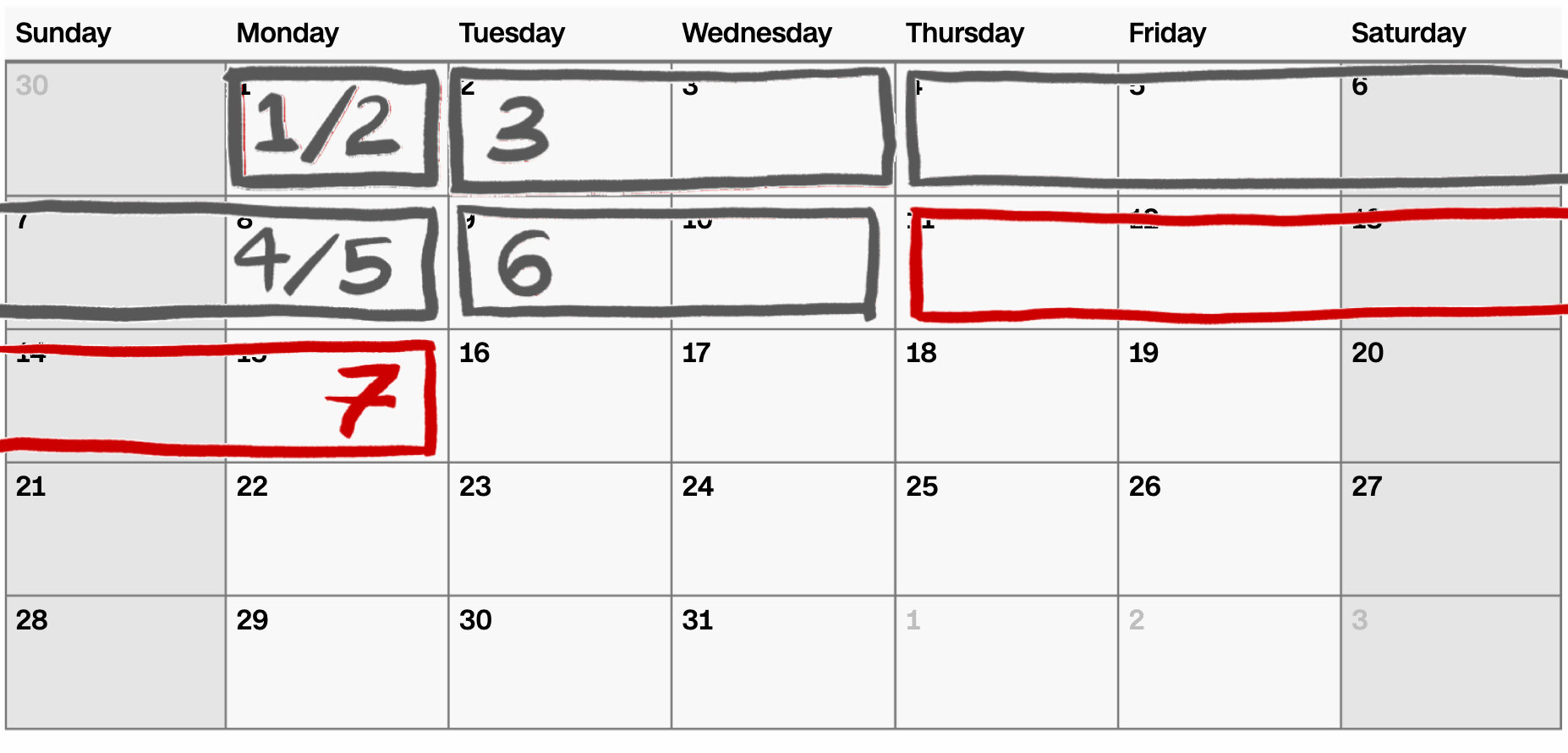| : Filibuster as "personal favor" Pressure campaign. Mitch McConnell, the Senate Minority leader and master of obstruction, asked Republican lawmakers for the "personal favor" of helping block a vote on a commission to investigate the January 6 insurrection, CNN reports. It's a long way from the indignation McConnell expressed that day at having the chamber he so loves sacked during the counting of electoral votes. And it makes his angry words for Trump and the rioters back then seem hollow now.
McConnell has 49 Republicans in his conference. It takes just 40 votes to make a filibuster happen and block a vote. We use that word so often -- filibuster -- and I don't think most people quite understand the arcane and frankly silly rules that have evolved to govern the Senate, which prides itself as being the world's greatest deliberative body, but doesn't deliberate on much of anything.
I asked Christopher Hickey from our interactive team to help me visualize the roadblocks utilized by the minority in the Senate (Democrats use them when they're in the minority too). I'll hand over the rest of today's edition to elements of what Christopher put together. : The bizarre rule that broke US government Passing legislation requires a supermajority of 60 votes to block a filibuster — votes that Democrats don't have now and may not have even after the midterm elections next year. Republicans haven't worked well with Democrats in years. Democrats have lost patience with Republicans. Neither party has a supermajority.
The two most substantial legislative accomplishments of the past 12 years — President Donald Trump's tax cuts and President Barack Obama's Affordable Care Act — were only achieved by one party finding a way around the filibuster.
Today, every piece of President Joe Biden's agenda — voting rights, immigration reform and updating infrastructure — faces an organized blockade by Republicans, who already refused to get on board with his Covid-19 stimulus plan in March. The deal brokered in the House to establish an independent, bipartisan commission to investigate the January 6 attack on the Capitol is also likely to die by filibuster.
So, in the absence of any sign Republicans will work with them, a growing pool of congressional Democrats are saying they now back reinterpreting Senate rules so they can pass legislation with a simple majority. They're going to need to convince their most conservative member, West Virginia Sen. Joe Manchin, to get on board, along with a handful of other Democratic holdouts.
Here's how the filibuster has made accomplishing anything on Capitol Hill incredibly difficult, and what could happen if the Senate rules are changed.  : How can a filibuster be beaten? The filibuster is not in the Constitution and is generally recognized as an accident of Senate rules. A bill is considered "filibuster-proof" if it has the support of at least 60 senators (it used to require 67 until a rule change in 1975). But few bills meet that criteria in today's hyper-partisan political climate, especially with the Senate's current 50-50 split between parties. Note: Sens. Bernie Sanders of Vermont and Angus King of Maine are shown here as Democrats; they are Independents who caucus with Democrats.
The only formal rule that can end a filibuster is the second paragraph of Senate Rule XXII, otherwise known as the cloture rule.
Invoking cloture just places a time limit on a bill's consideration and provides it with a path to move forward. 
Fifty years ago, cloture was almost never invoked. Today, filibuster threats are so common, cloture is required for nearly everything the Senate does. An added wrinkle is that bringing a bill to a vote requires unanimous consent — in other words, all 100 senators have to agree to hold a vote on a bill, an amendment or a presidential nomination.
If every senator is not on the same page, then the bill can only advance by breaking a filibuster on a motion to proceed — and that time-consuming process can take at least two days just to begin debate. In today's Congress, these votes to bring bills to a vote are often just another chance to filibuster.
Before 1970, there were fewer than 10 cloture votes in any given year. In 2021, there have been more than 40 and the year is not half done. Cloture rules have changed over time. The cloture rule was revised in the 1970s to require 60 votes instead of 67. In 2013, Democrats under former Senate Majority Leader Harry Reid changed the voting precedent through what's known as the "nuclear option" to confirm Obama's Cabinet nominees with a simple majority rather than a 60-vote supermajority.
Republicans then used that same option in 2017 to advance Trump's Supreme Court nominees. Those are the two exceptions; a supermajority is required to vote on and approve any other kind of Senate business.
Invoking cloture takes time. Lots of time. Even when cloture is invoked to end a filibuster, the time needed for the cloture process to play out can take time away on the calendar from other legislative business. Even after cloture is invoked, passing a bill can still take two weeks if the minority party insists on dragging things out. Let's take a look at the cloture process for a typical bill. (And, remember, senators are often not in session on Mondays and Fridays, so this calendar is very much an idealized sample schedule.)
Step 1: Say Democrats have a draft bill ready for a vote on the Senate floor, but they expect some level of opposition. Because voting on a bill requires the approval of all 100 senators ("unanimous consent"), on Monday, a senator instead takes the extra step of moving to take up the bill for consideration. That's a motion to proceed, the act of bringing the bill to the floor when unanimous consent can't be reached.
Step 2: A motion to proceed requires a vote and can be filibustered. If a filibuster has already begun or is expected, the senators in favor of the bill can present a cloture motion that same day.
Step 3: Cloture would end debate, stopping the filibuster, but it also requires a vote. Under the cloture rule, however, that vote can't happen until two days later, on Wednesday, the second day of session after the motion is made. On Wednesday, the Senate votes to invoke cloture on the motion to proceed. Assuming the bill's supporters succeed in securing 60 votes, the filibuster is shut down.
If the cloture vote is a success, a 30-hour period of consideration begins before senators can first vote on the motion to proceed. This includes time used for debate, roll call votes, quorum calls and other such actions.
But that's 30 session hours, not 30 chronological hours. Assuming the Senate keeps to eight hours in session per day, Monday through Friday, that period lasts nearly four workdays. By the time they vote on the motion to proceed (step 4), it's now mid-afternoon on the following Monday.
If that vote to proceed succeeds, the bill can head to the floor for consideration. Senators who oppose the bill might not be done yet. Now they have a second opportunity to initiate another filibuster, this time on the bill itself. Stopping this requires those in favor of the bill to file another cloture motion (step 5).
Step 6: Like with cloture on the motion to proceed, the vote to invoke cloture on the bill itself takes place two days after the motion is filed, on Wednesday. If the bill's defenders garner enough votes for cloture, then this begins another 30-hour period of consideration before the final vote can take place.
Step 7: When the vote to pass the bill begins, it's now the following Monday. That means the Senate has spent 15 calendar days on these filibuster-preventing actions before they can vote on the bill itself. The Senate can speed up the process, but only if there's an agreement from all 100 senators to quickly schedule a vote.  : Cloture ends filibusters because it ends everything else, too. According to Senate Rule XXII, once the Senate invokes cloture, "then said measure, motion or other matter pending before the Senate, or the unfinished business, shall be the unfinished business to the exclusion of all other business until disposed of." In other words, senators have to hit the brakes on everything but that clotured bill until they've brought the bill to a vote.
Now, instead of debating legislation one bill at a time, lawmakers cram as much into every bill as they can. There are fewer bills passed. They're just much, much longer. The 80th Congress of 1947 and 1948, which President Harry Truman famously attacked as the "Do Nothing Congress" during his 1948 re-election campaign, enacted 906 bills. That's more than three times the 283 bills that the 116th Congress produced in 2019 and 2020.  Why not end the filibuster? Republicans don't want to give up their power. And some Democrats, like West Virginia's Manchin, warn that if Washington seems hyper-partisan now, it would get much worse if one party could pass a bill without help from the other. His vote would be necessary to reinterpret the rules. Manchin and Biden both suggested earlier in 2021 that Congress revert filibusters to the talking-only, Mr. Smith style that was the norm before the 1960s. Pressure could build on Manchin, however, if the filibuster keeps Democrats from delivering on Biden's campaign promises.
Ahead of the Senate vote on whether to establish the Jan. 6 commission, CNN asked Manchin if he would invoke the nuclear option to blow up the filibuster if Republicans block the bill.
"No," he told CNN. "I can't take the fallout."
That all but ensures that the filibuster is here to stay.
: What are we doing here? We're trying to connect the dots at a time of political, cultural and economic upheaval. All CNN Newsletters | Manage Profile
® © 2021 Cable News Network, Inc. A WarnerMedia Company. All Rights Reserved.
One CNN Center Atlanta, GA 30303
|
Home › Without Label › Mutually assured obstruction and the bizarre rule that broke the US government





